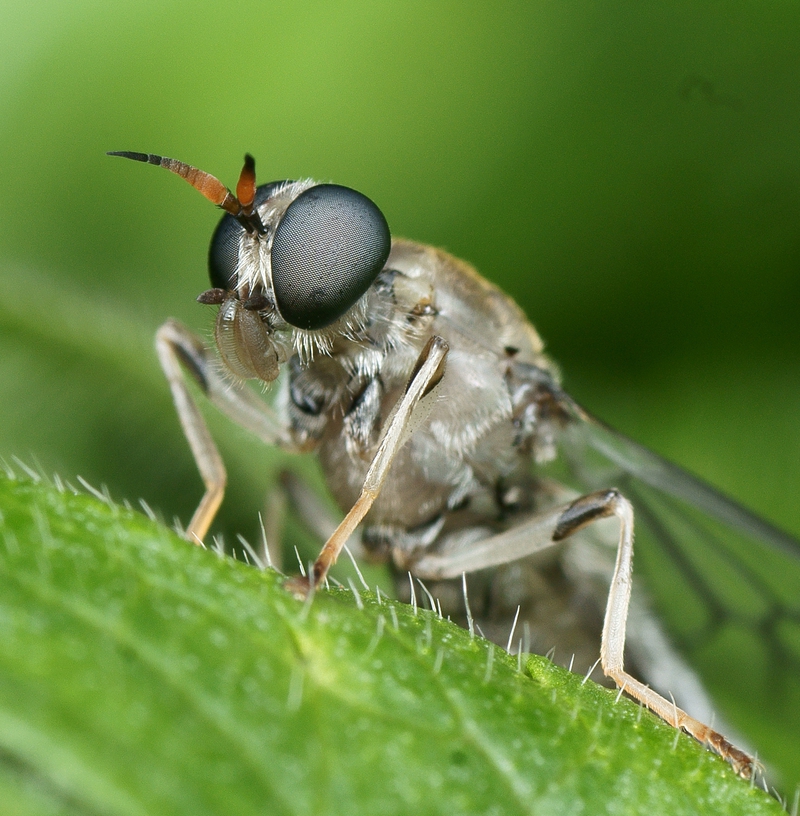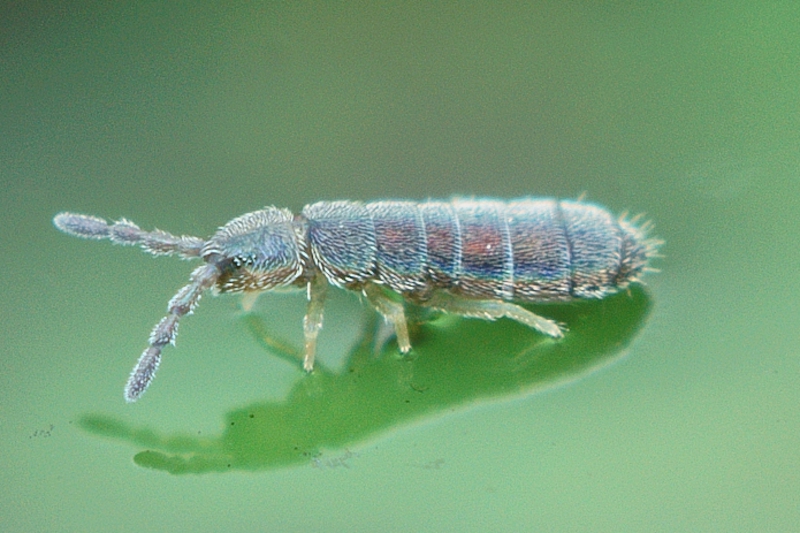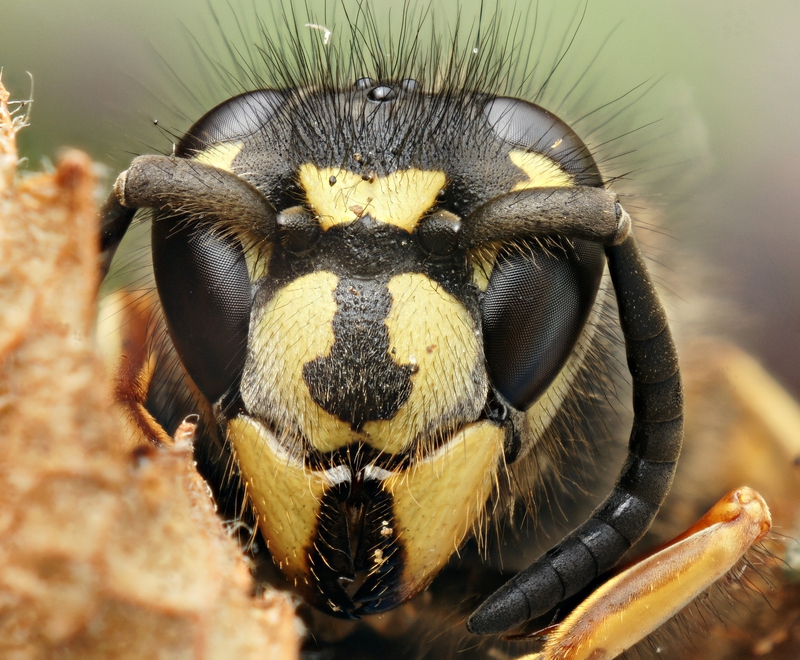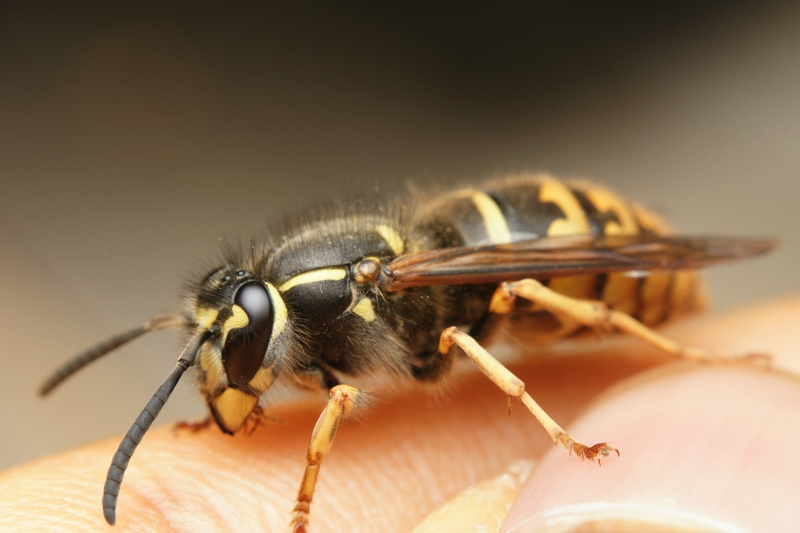TAGS: WHERNTO: erudite techniq

Our neighbors live in our yard!
Woodlouse (possibly Philoscia muscorum?)

Many, many of these and similar woodlice come out at night and munch on decaying vegetation. Interestingly, woodlice are crustaceans, belonging to the same class as crabs and shrimp.
Phidippus clarus female

Unfortunately I inadvertently disturbed this spider outside while working outside. The white fluff she's on is her home which resembles a "sleeping bag" of silk. After a couple of shots, she and her home were relocated to a safe place.
Winter cutworm

The larvae of the Large Yellow Underwing moth (Noctua pronuba), winter cutworms are a common sight here during the colder months. They come out to feed whenever there is a warm spell. This one was fairly large at 6cm or so in length.
Taken using a Tamron 90mm macro lens.
Fly's head

This fly was inadvertently disturbed when we had to move the plastic sheet it was hiding in. It was pretty calm and stayed still long enough to get this composite shot, focus stacked from 15 individual images.
Portrait of a male wolf spider

Somehow, this poor fellow got himself stranded in the house. He was very friendly and after I picked him up, he hung out on my hand for a while, even going through his cleaning routine there. Once released, he began scooting around every which way with great enthusiasm, stopping only occasionally. I was lucky he paused long enough for me to get this stack of 3 shots.
Weevil

Shortly before it was time to leave home for my piano lesson, I stumbled upon this weevil indoors. It may have found its way in on the fur of one of the cats or dog. As I didn't have much time, I hurriedly scooped it up with a leaf, took a couple of shots, and then released it outside.
Unidentified jumping spider on a blackberry stem

This jumping spider is exploring.
Callobius severus male

One of the larger males I've seen so far, this fellow was climbing up the side of our chimney, probably searching for a mate. The males can often be seen wandering about, poking into crevices here and there where a female might be likely to make a home.
He's missing a palp - perhaps from a conflict with another male?
The Arachmage

As with humans, true wizards and sorcerers are very difficult to find among spiderfolk. Needless to say, I was more than a little shocked to find this arachnid demonstrating his abilities by setting our compost ablaze.
Taken with a Pentax 55mm lens reversed on a full set of extension tubes if I recall.
Portrait of a female wolf spider

I found this ~8mm spider hanging around on our deck in the evening. As I'd been wanting to get a portrait of one of these spiders for some time, I offered her a red leaf which she obligingly crawled onto. After exploring it thoroughly, she found a comfortable spot and settled down in the above position for quite a while.
Focus stacked from four shots taken with a vintage Pentax 28mm lens reversed on a full set of extension tubes.
Carabid beetle with mite

These nocturnal beetles are all over the place as soon as winter's chill passes. They trundle along quickly and purposefully, stopping here and there to investigate their surroundings. They're particularly sensitive to the light I use to focus with and most run away when it gets too bright. This individual didn't care too much though and sat still for the better part of a minute.
Curiously, many have a mite riding around near their head. I've never seen more than one at a time. I imagine the mites are just passengers along for the ride. Maybe they help keep the beetles clean?
Female Callobius severus, front

- severus spiders are striking to behold. They are moderately large with body lengths of 2 cm or so and leg spans of up to 5 cm. Their cephalothorax and legs range in colour from dull pink to bright orange or even blood red. In the fall, males are easy to find along the side of the house as they search for mates. Females are harder to locate. They're experts in the art of reclusivity, hiding out in the most inaccessible places they can manage, only coming out late at night.
Most are easily startled and will disappear into their dwellings in the blink of an eye at the first sign of trouble. Unusually, this spider wasn't in the least bit concerned about my presence. She didn't even mind when I nudged her onto a piece of wood for some shots. After I'd finished, I put her back where I found her and she leisurely continued about her business as if nothing had happened.
Focus stacked from 5 images I think.
Female Callobius severus, top

Same spider as in last picture.
Adult male Evarcha proszynskii jumping spider, front

I found this fellow on the back deck and nudged him into a glass so I could move him somewhere else to be photographed. As it happened, I snapped some shots while he was still in the glass. 5 of them were suitable for stacking and resulted in this image.
Once he got out, he didn't seem very happy. He kept running around nervously, avoiding me when I got too close. I put him back where I found him quickly and he was fine after that.
Adult male Evarcha proszynskii jumping spider, top

Same spider as in last picture.
Another adult male Evarcha proszynskii

While working on clearing some wood to make way for our upcoming mini-farm, I noticed a familiar blob darting around on one of the pieces from some distance away. Sure enough, it was jumping spider. I'd been hoping to find another of this species, so I immediately set to work photographing him. His eyes were spectacular!
Focus stacked from 3 shots.
Cross orbweaver and morning glory vine

This wonderful spider with a very prominent cross on her back (distinctive of Araneus diatematus, the cross orbweavers) made a home around our deck. On occasion, one of the morning glory plants would make use of her threads if she wasn't careful! The vine was gone the next night. Perhaps she removed it or snipped the thread?
Robust Lancetooth snail

Apparently this snail was reading the soggy remains of a newspaper in our woodpile…
Dung fly

I think this fly is a female of the genus Scathophaga. She was busy enough with her cleaning routines that she didn't pay much attention to me or my equipment. These flies tend to be quite trusting, and if you approach slowly, they won't mind being observed at all.
Face-to-face with a fly!

This small fly was taking shelter in the insulated house our outdoor rabbits have. Since it was late at night, the fly was inactive and barely seemed to take notice of me hovering around with the camera.
Focus stacked from 7 shots taken with a 28mm prime lens reversed on a full set of extension tubes. The stack didn't turn out perfectly this time as you can see a few areas on the eyes that lack sharp focus.
Wood bug curled up

This large wood bug was found very near the beetle in DSC05413. I accidentally nudged the leaf it was on while trying to get a shot of the beetle, causing it to roll up into a very well-armoured ball. Due to this behaviour, another popular name for these crustaceans is "roly poly".
Woodlouse with unidentified purple insect (?)

I didn't notice the little insect on the woodlouse's head until played back an enlarged version of the shot on my camera. Fascinated, I watched through the magnified view of my lens as the purple critter explored its ride, which didn't seem to take any notice. Once satisfied, it dropped down and scuttled off at a surprising speed.
Face of a cross orbweaver

This female Araneus diadematus spider had just finished producing an egg sac and was wandering around on our deck. After a brief tour, she returned to guard the sac and remained there for a few days.
Male wolf spider

Around here, wolf spiders often endure the colder days of winter clinging to the side of the house. When the chill finally ends and the sun begins to warm the ground again, they positively leap down and start foraging as quickly as they possibly can. Even in early February, they are so numerous in parts of the yard that you have to watch your step!
This ~6-7mm male was pretty cooperative and didn't mind me getting close with the camera. He just kept going, occasionally stopping for a brief rest.
The odd white patch on his right fang might be some kind of fungus, but I'm not sure.
Pentax 55mm reversed on a extension tubes.
Unidentified jumping spider

Another of those endearing jumping spiders!
Pellenes sp. jumping spider, front

A new species for me when I found it, this small (~4mm) jumping spider was extremely cooperative! It hopped as much as walked, but frequently stopped to take long looks at anything that moved. Focus stacked from about 4 shots.
Pellenes sp. jumping spider, top

Top view of the same spider in last picture.
Pellenes sp. jumper

Like the spider in the last picture, this one was pretty calm and cooperative. It wandered freely between a dandelion leaf I was trying to shoot it on and my hand, inevitably attempting to work its way up my sleeve when it got the chance. The blue background is actually the sky, which the spider and leaf were held up against for the shot.
Fly with pseudoscorpion

This shot came as a complete surprise. I didn't notice the pseudoscorpion attached to the fly's leg when I took it. According to Wikipedia, pseudoscorpions are known to hitch rides on insects - a very efficient means of travel for such tiny creatures! The fly didn't seem disturbed by the presence of its passenger.
A springtail's face

Despite possessing six legs, springtails are not insects. They are one of the most numerous macroscopic animals with densities of perhaps 100,000 per cubic metre of soil in many parts of the world! We rarely see them because they are so small.
Their name comes from a special "tail" folded beneath their abdomen. It is a two-pronged lever-like appendage that is kept under tension. When released, it can fling a springtail up to 15cm into the air – the equivalent of a human being jumping over the Eiffel Tower!
This individual was moderately large at a length of 2mm or so and was warming itself in the sun with several associates.
Focus stacked from 3 shots taken with a Pentax 28mm reversed on a full set of extension tubes.
Garden soldier fly (Exaireta spinigera)

Lots of these critters come out of our composts at various times of the year. After a few hours, they turn black and take flight. Could this be some kind of nymph stage or does it just take a while for their adult colouration to set in?
Female Phidippus borealis jumping spider

I regularly patrol the yard looking for these jumping spiders as they are very striking. They're large, up to 2 cm in body length, and have bright red or orange markings on their abdomens. They also have colourful metallic fangs, a trait they share with many other Phidippus spiders.
Being as big as they are, it's a fascinating experience to meet one face to face. When you look at them, you see a pair of calculating, intelligent eyes staring back at you. Some will be curious and come closer, even hopping onto you on occasion.
This one was casually ambling about near the house. I think she may have moulted recently because she was very clean and well groomed, with hardly a hair out of place.
Female Phidippus borealis jumping spider, close-up

Close-up of same spider as in last pic.
Young Arion slug feeding on a dandelion

While testing out a new macro setup, I happened upon this slug. It was very busy with its head buried deep inside the flower. These slugs are some of the most common here and will eat all sorts of stuff. Unlike most of the shots so far in this gallery, this was taken without flash, in shade on a sunny day.
Unidentified purple critter

The same kind of creature as in 'IMGP8076', this one was dancing on water that had collected in a planting pot. At a mere 1.5-2mm in length it was easily supported by the surface tension.
Yellowjacket queen

Our last snowfall was heavy and probably disturbed the hibernating places of many creatures. I suspect this yellowjacket queen was among those unfortunate enough to have been awakened prematurely. I found her huddled up against a pot out on our deck. It was very cold and she could barely move. Seeing as it was late in the evening and would only get colder at night, I decided to bring her in since she didn't have a suitably cozy hiding spot. I kept her in the same room that our slugs live in which was cool enough that she wouldn't get too active overnight.
By noon the next day, she had had quite enough of the container I was keeping her in and wanted out. Luckily, it was unexpectedly sunny and warm, so I thought there was a good chance she could find a new place to wait out the rest of the winter. After crawling around on my hand for a several minutes and snacking quickly on a piece of apple, she flew off.
Focus stacked from 7 shots taken with a 28mm prime lens reversed on a short extension tube.
Yellowjacket queen preparing to depart

The same queen as in last picture exploring my hand a few minutes before she took off.
Taken with a Pentax 55mm reversed on a couple of extension tubes.
A very colourful cross orbweaver

Another spectacular cross orbweaver!
Small cave cricket

I found this cute little insect under a board outside. It wasn't nearly as skittish as some of its conspecifics and obligingly remained perched on the leaf for a couple of minutes.
Cave crickets are frequent visitors to our deck and eat just about anything they can find.
Globular springtail

Often when I'm photographing a subject, I'll end up coming across many other interesting thing in the vicinity. In this case, I was shooting a Platycryptus californicus jumping spider when I noticed this springtail a few centimeters away, slowly making its way up a blade of grass.
Xysticus crab spider in the snow

Normally, you might not think of a frigid snowscape as a hospitable environment for little creatures to be out and about in. If you look closely, though, you may be surprised!
This 3-4mm crab spider was found foraging amongst the ice crystals on the surface. The temperature was slightly above freezing, so maybe it was just warm enough to permit activity.
It was by no means alone out there! Several other spiders were scurrying around, along with a few insects (or possibly springtails - I didn't get a good look), pseudoscorpions, and even worms.
Focus stacked from two shots taken with a Pentax 28mm reversed on a full set of extension tubes.
Wet soldier fly (Exaireta spinigera)!

I found this fully mature soldier fly hanging out on the compost bin we keep near our garden. The water droplets acted here to further magnify parts of the eye!
Female trap-door spider

A rare sight above ground, adult female trap-door spiders around here normally spend most of their lives in their burrows. I don't know what this one was up to, but she was wandering around out in the open. She wasn't in any hurry and sat absolutely still for a few shots, this one focus stacked from 9 images.
Trap-door spiders are mygalomorphs and more closely related to tarantulas than many commonly known spiders like wolf spiders, orb weavers, and jumpers. Unlike the latter types, mygalomorphs have fangs which point straight down and don't cross. Many can also live well over 10 years.
Little jumping spider

I have yet to find out exactly what this cute spider is. Perhaps a male Pellenes jumper? I found him out in the backyard. Like many jumping spiders, he was eager to explore and gladly hopped onto a red leaf I held out for him.
Hoverfly feeding on a dandelion

Hoverflies are extremely capable fliers, able to hold absolutely still in the air for extended periods or dart off in any direction of their choosing at a moment's notice. I find them less skittish than some other flies. This one was particularly unconcerned and let me get quite close. Shot in natural light.
